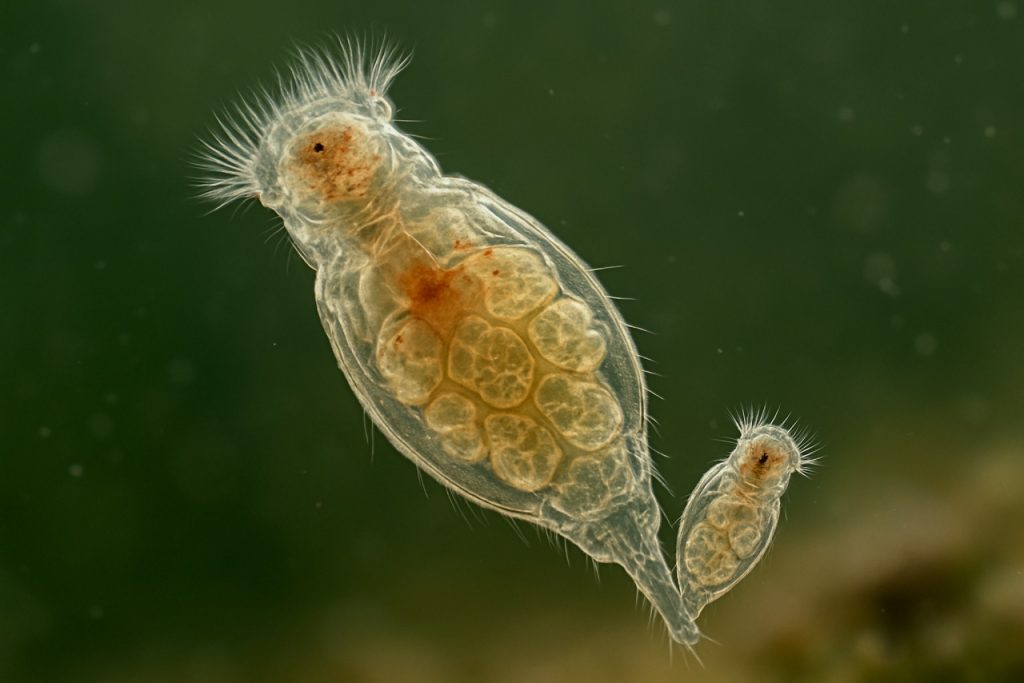
How Amphimictic Reproduction Shapes Rotifer Evolution: The Hidden Dynamics of Sexual Reproduction in Microscopic Aquatic Life. Discover Why This Process Matters for Biodiversity and Scientific Innovation. (2025)
- Introduction to Rotifers and Their Reproductive Strategies
- Defining Amphimictic Reproduction: Mechanisms and Significance
- Comparative Analysis: Amphimictic vs. Parthenogenetic Reproduction
- Genetic Diversity and Evolutionary Advantages in Rotifers
- Environmental Triggers and Regulation of Amphimictic Reproduction
- Molecular and Cellular Processes Underlying Amphimixis
- Ecological Impacts and Population Dynamics
- Current Research Frontiers and Technological Advances
- Market and Public Interest: Trends and Forecasts (Estimated 15% Growth in Academic and Biotech Sectors by 2030)
- Future Outlook: Applications in Biodiversity, Aquaculture, and Synthetic Biology
- Sources & References
Introduction to Rotifers and Their Reproductive Strategies
Rotifers are microscopic, aquatic invertebrates belonging to the phylum Rotifera, widely distributed in freshwater and marine environments. Renowned for their ecological versatility and rapid life cycles, rotifers play a crucial role in aquatic food webs, serving as primary consumers and prey for larger organisms. Their reproductive strategies are diverse and have evolved to maximize survival in fluctuating environments. Among these strategies, amphimictic reproduction—sexual reproduction involving the fusion of male and female gametes—stands out as a key mechanism for generating genetic diversity within rotifer populations.
Amphimictic reproduction in rotifers typically occurs in response to environmental cues such as changes in population density, food availability, or other stressors. In many rotifer species, particularly those within the class Monogononta, populations are predominantly female and reproduce asexually (parthenogenesis) under favorable conditions. However, when environmental conditions become less optimal, some females produce haploid eggs that, if unfertilized, develop into males. These males are usually short-lived and non-feeding, but they play a vital role in the sexual phase by fertilizing haploid eggs produced by females, resulting in the formation of diploid, resting (diapausing) eggs. These resting eggs are highly resistant to desiccation and other adverse conditions, enabling the species to persist through unfavorable periods and recolonize habitats when conditions improve.
The alternation between asexual and amphimictic reproduction in rotifers is a classic example of cyclical parthenogenesis, a reproductive strategy that balances the rapid population growth afforded by asexual reproduction with the long-term benefits of genetic recombination provided by sexual reproduction. This dual strategy enhances the adaptability and evolutionary potential of rotifer populations, allowing them to respond effectively to environmental variability and selective pressures.
Research into the molecular and ecological aspects of amphimictic reproduction in rotifers has provided valuable insights into the mechanisms underlying reproductive switching and the evolutionary significance of sexual reproduction in microscopic animals. Organizations such as the National Science Foundation and the National Institutes of Health have supported studies exploring the genetic regulation of reproductive modes and the ecological consequences of amphimixis in rotifer communities. These investigations contribute to a broader understanding of reproductive evolution and the resilience of aquatic ecosystems.
Defining Amphimictic Reproduction: Mechanisms and Significance
Amphimictic reproduction, also known as sexual reproduction, is a fundamental biological process in rotifers, a diverse group of microscopic aquatic invertebrates. In this mode of reproduction, genetic material from two distinct parental individuals—typically male and female—combines to produce genetically unique offspring. This process contrasts with parthenogenesis, another common reproductive strategy in rotifers, where females produce offspring without fertilization. Amphimictic reproduction in rotifers involves the production of haploid gametes (eggs and sperm) through meiosis, followed by fertilization to restore diploidy in the resulting zygote.
The mechanisms underlying amphimictic reproduction in rotifers are closely linked to environmental cues. Many rotifer species, particularly those in the class Monogononta, alternate between asexual and sexual reproduction depending on ecological conditions. Under favorable circumstances, rotifers reproduce asexually, rapidly increasing population size. However, when environmental stressors such as crowding, food scarcity, or changes in temperature arise, females begin to produce haploid eggs that, if unfertilized, develop into males. These males then fertilize other haploid eggs, resulting in the formation of resting or diapausing eggs. These resting eggs are highly resistant to desiccation and other adverse conditions, enabling the species to survive until the environment becomes favorable again.
The significance of amphimictic reproduction in rotifers extends beyond mere survival. By facilitating genetic recombination, this reproductive strategy enhances genetic diversity within populations. Increased genetic variability is crucial for adaptation to changing environments, resistance to pathogens, and long-term evolutionary success. The production of resting eggs through amphimictic reproduction also plays a vital ecological role, as these eggs can remain dormant for extended periods, contributing to the persistence and dispersal of rotifer populations in fluctuating aquatic habitats.
Rotifers, particularly those in the phylum Rotifera, are recognized as important model organisms in studies of reproductive biology, ecology, and evolutionary dynamics. Their reproductive versatility, including the capacity for both amphimictic and parthenogenetic reproduction, makes them valuable for investigating the evolutionary advantages of sexual reproduction. Organizations such as the National Science Foundation and the Nature Publishing Group have supported and disseminated research on rotifer reproductive strategies, highlighting their significance in aquatic ecosystems and evolutionary studies.
Comparative Analysis: Amphimictic vs. Parthenogenetic Reproduction
Amphimictic reproduction, characterized by the fusion of male and female gametes, is one of the two principal reproductive strategies observed in rotifers, the other being parthenogenesis. Rotifers, microscopic aquatic animals belonging to the phylum Rotifera, display remarkable reproductive plasticity, with many species capable of alternating between these two modes depending on environmental conditions. This section provides a comparative analysis of amphimictic and parthenogenetic reproduction in rotifers, highlighting their biological significance, ecological implications, and evolutionary consequences.
In amphimictic reproduction, sexual reproduction occurs through the production of haploid eggs by females, which must be fertilized by male sperm to develop into viable offspring. This process introduces genetic recombination, resulting in increased genetic diversity within populations. Such diversity is advantageous in fluctuating or challenging environments, as it enhances the adaptive potential of the species. In rotifers, amphimictic reproduction is typically triggered by environmental stressors such as crowding, changes in temperature, or food scarcity. These cues induce the production of mictic (sexual) females, which generate haploid eggs. If these eggs are not fertilized, they develop into males; if fertilized, they give rise to resting eggs capable of withstanding adverse conditions, thus ensuring species survival during unfavorable periods.
In contrast, parthenogenetic reproduction in rotifers involves the development of offspring from unfertilized diploid eggs, produced by amictic (asexual) females. This mode allows for rapid population growth under stable and favorable conditions, as it bypasses the need for males and fertilization. However, parthenogenesis results in clonal offspring, limiting genetic variability and potentially reducing the population’s ability to adapt to environmental changes or resist pathogens.
The alternation between amphimictic and parthenogenetic reproduction, known as cyclical parthenogenesis, is a hallmark of many rotifer species, particularly within the class Monogononta. This reproductive flexibility is considered a key factor in the ecological success and widespread distribution of rotifers in freshwater and marine habitats. The production of dormant, resistant resting eggs through amphimictic reproduction is especially important for surviving periods of desiccation, freezing, or other environmental extremes.
Comparative studies underscore that while parthenogenesis confers short-term advantages in terms of rapid colonization and population expansion, amphimictic reproduction is essential for long-term evolutionary resilience. The balance between these strategies is regulated by both intrinsic genetic mechanisms and extrinsic environmental factors, reflecting the complex life history adaptations of rotifers. For further information on rotifer biology and reproductive strategies, authoritative resources such as the National Science Foundation and the Nature Publishing Group provide comprehensive scientific insights.
Genetic Diversity and Evolutionary Advantages in Rotifers
Amphimictic reproduction, or sexual reproduction involving the fusion of gametes from two distinct individuals, plays a pivotal role in the genetic diversity and evolutionary adaptability of rotifers. Rotifers, microscopic aquatic animals found in freshwater and marine environments, exhibit both asexual (parthenogenetic) and sexual (amphimictic) reproductive strategies. The alternation between these modes is a hallmark of their life cycle, particularly in the class Monogononta, which encompasses the majority of rotifer species.
During periods of environmental stability, rotifers predominantly reproduce asexually, producing genetically identical offspring. However, when environmental conditions become unfavorable—such as during crowding, food scarcity, or seasonal changes—rotifers switch to amphimictic reproduction. This process involves the production of haploid males and sexual females, leading to the formation of resting eggs through fertilization. These resting eggs are highly resistant to desiccation and extreme temperatures, enabling rotifer populations to survive adverse conditions and disperse to new habitats.
The genetic recombination inherent in amphimictic reproduction is crucial for generating genetic diversity within rotifer populations. This diversity enhances the ability of populations to adapt to changing environments, resist pathogens, and exploit new ecological niches. Studies have shown that populations with regular sexual cycles exhibit greater genetic variability, which is associated with increased evolutionary potential and resilience (National Science Foundation). The production of resting eggs through amphimixis also facilitates long-distance dispersal, as these eggs can remain dormant for extended periods and hatch when conditions become favorable, contributing to the colonization of new habitats and the maintenance of metapopulation dynamics.
From an evolutionary perspective, the facultative nature of amphimictic reproduction in rotifers represents a balance between the rapid population growth afforded by asexual reproduction and the long-term benefits of genetic diversity provided by sexual reproduction. This dual strategy allows rotifers to rapidly exploit favorable conditions while maintaining the genetic toolkit necessary for adaptation and survival in fluctuating environments. The evolutionary success of rotifers, reflected in their global distribution and ecological versatility, is thus closely linked to the interplay between their reproductive modes and the genetic diversity generated through amphimictic reproduction (European Bioinformatics Institute).
Environmental Triggers and Regulation of Amphimictic Reproduction
Amphimictic reproduction in rotifers, characterized by the fusion of male and female gametes, is a complex process tightly regulated by environmental cues. Unlike asexual (parthenogenetic) reproduction, amphimixis in rotifers is typically induced under specific environmental conditions that signal impending stress or unfavorable changes, such as crowding, food scarcity, or shifts in temperature and photoperiod. These triggers are crucial for the production of diapausing, or resting, eggs that can withstand adverse conditions and ensure species survival.
One of the primary environmental triggers for amphimictic reproduction is population density. As rotifer populations grow and resources become limited, chemical signals—often referred to as “crowding factors”—accumulate in the environment. These factors stimulate the switch from asexual to sexual reproduction, leading to the production of males and the initiation of meiosis in females. The resulting fertilized eggs are typically encased in protective shells, allowing them to remain dormant until conditions improve. This adaptive strategy is well-documented in several rotifer genera, including Brachionus and Keratella.
In addition to crowding, food availability plays a significant role in regulating amphimictic reproduction. Nutrient depletion acts as a stressor, prompting rotifers to invest in the production of resting eggs through sexual reproduction. This ensures that offspring are produced only when the likelihood of survival is maximized, either by immediate hatching under favorable conditions or by remaining dormant during periods of scarcity.
Temperature and photoperiod are also influential environmental factors. Seasonal changes, particularly in temperate regions, can trigger the onset of amphimictic reproduction. For example, decreasing temperatures and shorter daylight hours in autumn often coincide with increased production of resting eggs, aligning the reproductive cycle with environmental predictability. This synchronization enhances the chances of population persistence through harsh winters or dry seasons.
The regulation of amphimictic reproduction in rotifers is mediated by a combination of endocrine and molecular mechanisms. Hormonal signals, such as those involving juvenile hormone analogs, have been implicated in the induction of sexual reproduction. Recent advances in molecular biology have begun to elucidate the genetic pathways involved, although much remains to be discovered about the precise regulatory networks.
Understanding the environmental triggers and regulatory mechanisms of amphimictic reproduction in rotifers is essential for ecological studies, aquaculture, and the management of freshwater ecosystems. Organizations such as the Elsevier and the European Bioinformatics Institute provide access to a wealth of peer-reviewed research and genomic data that continue to advance our knowledge in this field.
Molecular and Cellular Processes Underlying Amphimixis
Amphimictic reproduction in rotifers, a process involving the fusion of male and female gametes, is underpinned by a series of intricate molecular and cellular mechanisms. Rotifers, particularly those in the class Monogononta, exhibit cyclical parthenogenesis, alternating between asexual and sexual (amphimictic) reproduction depending on environmental cues. The transition to amphimixis is typically triggered by factors such as population density, food scarcity, or other stressors, which induce the production of mictic females capable of generating haploid eggs through meiosis.
At the cellular level, amphimictic reproduction begins with the differentiation of mictic females, whose oocytes undergo meiosis to produce haploid gametes. These eggs, if unfertilized, develop into haploid males, a process unique to rotifers. The males, in turn, produce haploid sperm via mitosis, as their simplified reproductive systems lack the capacity for meiosis. Fertilization occurs when a male transfers sperm to a mictic female, resulting in the formation of a diploid zygote. This zygote develops a thick, protective shell, becoming a resting or diapausing egg capable of withstanding adverse environmental conditions for extended periods.
Molecularly, the switch from asexual to sexual reproduction is regulated by a network of signaling pathways and gene expression changes. Environmental stressors are sensed by the rotifer, leading to the upregulation of genes involved in meiosis and gametogenesis. Key molecular players include cyclin-dependent kinases and other cell cycle regulators that orchestrate the progression of meiosis. Additionally, epigenetic modifications, such as DNA methylation and histone acetylation, are believed to play roles in modulating gene expression during the transition to amphimixis.
Recent advances in genomics and transcriptomics have enabled the identification of specific genes and regulatory elements involved in rotifer sexual reproduction. For example, studies have highlighted the importance of genes associated with meiosis, fertilization, and stress response in facilitating the switch to amphimictic reproduction. Furthermore, the molecular machinery responsible for the formation of the diapausing egg shell involves the coordinated expression of structural proteins and enzymes, ensuring the survival of the zygote under unfavorable conditions.
Understanding these molecular and cellular processes not only sheds light on the evolutionary success of rotifers in fluctuating environments but also provides broader insights into the regulation of sexual reproduction in microinvertebrates. Research in this area is supported by organizations such as the National Science Foundation and the National Institutes of Health, which fund studies on developmental biology and reproductive mechanisms in aquatic organisms.
Ecological Impacts and Population Dynamics
Amphimictic reproduction, involving the fusion of male and female gametes, plays a pivotal role in the ecological dynamics and population structure of rotifers. Rotifers, microscopic aquatic animals found in diverse freshwater and marine environments, exhibit both asexual (parthenogenetic) and sexual (amphimictic) reproductive strategies. The alternation between these modes is often triggered by environmental cues such as population density, food availability, and seasonal changes, which in turn influence the genetic diversity and adaptability of rotifer populations.
In ecological terms, amphimictic reproduction is crucial for generating genetic variation within rotifer populations. This genetic diversity enhances the resilience of populations to environmental stressors, such as fluctuations in temperature, salinity, and the presence of pathogens. During periods of environmental stability, rotifers predominantly reproduce asexually, leading to rapid population growth. However, when conditions become unfavorable or crowded, the switch to amphimictic reproduction results in the production of resting eggs—durable, dormant stages that can withstand adverse conditions and facilitate dispersal. These resting eggs contribute to the long-term persistence and colonization ability of rotifer populations, ensuring their survival across variable habitats and through seasonal cycles.
The population dynamics of rotifers are thus tightly linked to their reproductive strategy. Amphimictic reproduction typically leads to a temporary decline in population growth rates due to the energy investment in sexual processes and resting egg formation. However, this is offset by the long-term benefits of increased genetic diversity and the establishment of egg banks in sediments, which serve as reservoirs for future population outbreaks. This dynamic is particularly evident in cyclical parthenogens such as Brachionus and Keratella, where population booms are followed by sexual phases and the deposition of resting eggs, as documented by research from leading aquatic ecology organizations.
From an ecological perspective, the ability of rotifers to switch between reproductive modes allows them to exploit ephemeral habitats and respond rapidly to environmental changes. This flexibility not only stabilizes their populations but also influences community structure and nutrient cycling in aquatic ecosystems. Rotifers often serve as primary consumers and are integral to the transfer of energy from phytoplankton to higher trophic levels, underscoring their ecological importance. The study of amphimictic reproduction in rotifers continues to inform our understanding of evolutionary strategies in microinvertebrates and their role in ecosystem functioning, as recognized by authorities such as the Ecological Society of America and the Association for the Sciences of Limnology and Oceanography.
Current Research Frontiers and Technological Advances
Amphimictic reproduction, the process involving sexual reproduction with the fusion of male and female gametes, is a defining feature in many rotifer species, particularly within the class Monogononta. In recent years, research on amphimictic reproduction in rotifers has advanced significantly, driven by both fundamental biological questions and applied interests in ecology, evolutionary biology, and aquaculture. As of 2025, several research frontiers and technological advances are shaping the field.
One major research frontier is the molecular and genetic regulation of sexual reproduction in rotifers. Advances in high-throughput sequencing and transcriptomics have enabled researchers to identify key genes and signaling pathways involved in the switch between asexual (parthenogenetic) and sexual (amphimictic) reproduction. These studies are elucidating the environmental cues—such as population density, food availability, and chemical signals—that trigger the production of males and resting eggs, which are essential for survival under adverse conditions. The National Science Foundation and other major research funding bodies have supported projects that use CRISPR/Cas9 and RNA interference to manipulate gene expression in rotifers, providing new insights into the genetic control of amphimixis.
Another frontier is the application of advanced imaging and microfluidic technologies to study rotifer reproduction in real time. High-resolution microscopy and live-cell imaging allow for detailed observation of gamete formation, fertilization, and embryonic development. Microfluidic platforms, developed in collaboration with engineering institutes and supported by organizations such as the National Institutes of Health, enable precise manipulation of environmental conditions, facilitating controlled studies of reproductive responses.
Technological advances have also improved the use of rotifers as model organisms in ecotoxicology and evolutionary studies. The ability to induce and monitor amphimictic reproduction in laboratory cultures has made it possible to assess the effects of pollutants, pharmaceuticals, and climate change on reproductive success and genetic diversity. The United States Environmental Protection Agency recognizes rotifers as important bioindicators, and ongoing research is refining protocols for their use in environmental monitoring.
Finally, the integration of bioinformatics and systems biology is enabling the construction of comprehensive models of rotifer reproductive cycles. These models incorporate genomic, transcriptomic, and environmental data to predict population dynamics and evolutionary trajectories. As research continues, collaborations between academic institutions, governmental agencies, and international organizations are expected to further accelerate discoveries in the amphimictic reproduction of rotifers, with implications for biodiversity conservation, aquaculture, and environmental management.
Market and Public Interest: Trends and Forecasts (Estimated 15% Growth in Academic and Biotech Sectors by 2030)
Amphimictic reproduction in rotifers—sexual reproduction involving the fusion of male and female gametes—has garnered increasing attention in both academic and biotechnology sectors. This interest is driven by the unique genetic diversity and adaptability conferred by amphimixis, which contrasts with the more common parthenogenetic (asexual) reproduction in many rotifer species. The ability of rotifers to switch between reproductive modes under environmental stress makes them valuable models for evolutionary biology, genetics, and applied research.
Recent trends indicate a robust growth in research and commercial applications related to amphimictic reproduction in rotifers. Academic interest is reflected in the rising number of peer-reviewed publications and funded projects focusing on the genetic mechanisms, ecological significance, and evolutionary implications of amphimixis. This surge is supported by major scientific organizations and funding bodies, such as the National Science Foundation and the National Institutes of Health, which have prioritized studies on reproductive strategies and genetic diversity in aquatic microfauna.
In the biotechnology sector, amphimictic rotifers are increasingly recognized for their potential in aquaculture, environmental monitoring, and genetic engineering. Companies and research institutions are exploring the use of amphimictic rotifer strains to enhance the genetic robustness of live feed in fish hatcheries, improve water quality assessment protocols, and serve as model organisms for gene-editing technologies. The Food and Agriculture Organization of the United Nations has highlighted the importance of rotifers in sustainable aquaculture, noting their role in supporting early larval stages of commercially important fish species.
Market analyses project an estimated 15% growth in academic and biotech activities related to amphimictic rotifers by 2030. This forecast is underpinned by increasing investments in life sciences infrastructure, expanding interdisciplinary collaborations, and the integration of advanced genomic tools. The global push for sustainable aquaculture and the need for resilient model organisms in environmental research further fuel this upward trend. Leading universities, government agencies, and international organizations are expected to play pivotal roles in shaping the future landscape of rotifer research and its applications.
Overall, the convergence of scientific curiosity and practical demand is set to drive significant advancements in the study and utilization of amphimictic reproduction in rotifers, with broad implications for biodiversity, biotechnology, and ecosystem management.
Future Outlook: Applications in Biodiversity, Aquaculture, and Synthetic Biology
Amphimictic reproduction in rotifers, characterized by the fusion of male and female gametes, holds significant promise for future applications across biodiversity conservation, aquaculture, and synthetic biology. As research advances into 2025, the unique reproductive strategies of rotifers are increasingly recognized for their potential to address pressing challenges in these fields.
In biodiversity conservation, amphimictic reproduction offers a valuable model for understanding genetic diversity and population resilience. Rotifers, particularly those in the class Monogononta, exhibit cyclical parthenogenesis, alternating between asexual and sexual (amphimictic) reproduction. This flexibility enables rapid population growth during favorable conditions and the generation of resting eggs through sexual reproduction, which can withstand environmental stressors. Such mechanisms are crucial for maintaining genetic variability and adaptability in fluctuating habitats. Insights from rotifer reproductive biology are informing conservation strategies for other aquatic microfauna, supporting efforts to preserve ecosystem function and resilience in the face of climate change and habitat degradation. Organizations such as the International Union for Conservation of Nature (IUCN) emphasize the importance of genetic diversity for species survival, and rotifers serve as a model for these principles.
In aquaculture, rotifers are a cornerstone live feed for larval fish and crustaceans due to their small size, high nutritional value, and ease of mass culture. The ability to induce amphimictic reproduction in rotifer cultures allows for the production of diapausing eggs, which can be stored and hatched on demand, ensuring a reliable supply of live feed. This is particularly valuable for hatcheries seeking to optimize production cycles and respond to market fluctuations. Research into the genetic and environmental triggers of amphimictic reproduction is enabling more efficient management of rotifer populations, reducing the risk of culture crashes and improving the sustainability of aquaculture operations. The Food and Agriculture Organization of the United Nations (FAO) recognizes the critical role of rotifers in global aquaculture and supports research into their biology and cultivation.
Synthetic biology stands to benefit from the study of amphimictic reproduction in rotifers as well. The mechanisms underlying their reproductive switching, stress tolerance, and genetic recombination are inspiring novel approaches to engineering robust, adaptable microorganisms. By harnessing these traits, researchers aim to develop synthetic systems capable of surviving harsh environments or rapidly evolving in response to selective pressures. Such innovations have potential applications in bioremediation, industrial biotechnology, and the development of new genetic tools. Collaborative efforts between academic institutions and organizations like the European Molecular Biology Laboratory (EMBL) are driving forward the integration of rotifer biology into synthetic biology platforms.
Looking ahead, the continued exploration of amphimictic reproduction in rotifers is poised to yield transformative advances across multiple disciplines, reinforcing their status as both a model organism and a practical resource for sustainable development.
Sources & References
- National Science Foundation
- National Institutes of Health
- Nature Publishing Group
- European Bioinformatics Institute
- Elsevier
- Food and Agriculture Organization of the United Nations
- International Union for Conservation of Nature
- European Molecular Biology Laboratory



